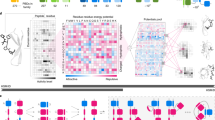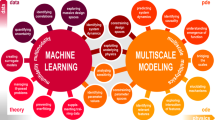Abstract
The Physiome Project will provide a framework for modelling the human body, using computational methods that incorporate biochemical, biophysical and anatomical information on cells, tissues and organs. The main project goals are to use computational modelling to analyse integrative biological function and to provide a system for hypothesis testing.
This is a preview of subscription content, access via your institution
Access options
Subscribe to this journal
Receive 12 print issues and online access
$189.00 per year
only $15.75 per issue
Buy this article
- Purchase on Springer Link
- Instant access to full article PDF
Prices may be subject to local taxes which are calculated during checkout




Similar content being viewed by others

References
International Human Genome Mapping Consortium. A physical map of the human genome. Nature 409, 934–941 (2001).
Venter, C. et al. The sequence of the human genome. Science 291, 1304–1351 (2001).
Noble, D. Biological computation. Encyclopedia of Life Sciences [online], (DOI 10.1038/npg.els.0003433), http://www.els/net (2002).
Noble, D. The rise of computational biology. Nature Rev. Mol. Cell Biol. 3, 460–463 (2002).
Kitano, H. Systems biology: a brief overview. Science 295, 1662–1664 (2002).
Kitano, H. Computational systems biology. Nature 420, 206–210 (2002).
Rao, C. V., Wolf, D. M. & Arkin, A. P. Control, exploitation and tolerance of intracellular noise. Nature 420, 231–237 (2002).
Goldbeter, A. Computational approaches to cellular rhythms. Nature 420, 238–245 (2002).
Edelstein-Keshet, L. Mathematical Models in Biology (Random House, New York, 1988).
Keener, J. & Sneyd, J. Mathematical Physiology (Springer, New York, 1998).
Bower, J. M. & Bolouri, H. (eds). Computational Modeling of Genetic and Biochemical Networks (MIT Press, Cambridge, Massachusetts, 2001).
Fall, C. P., Marland, E. S., Wagner, J. M. & Tyson, J. J. Computational Cell Biology (Springer, New York, 2002).
Christie, G. R., Bullivant, D. P., Blackett, S. A. & Hunter, P. J. Modelling and visualising the heart. Computing. Vis. Sci. 4, 227–235 (2002).
Kohl, P., Noble, D. & Hunter, P. J. (eds). The integrated heart: modelling cardiac structure and function. Phil. Trans. R. Soc. A 359 (2001).
Smith, N. P. et al. Mathematical modelling of the heart: cell to organ. Chaos, Solitons Fractals 13, 1613–1621 (2001).
Smith, N. P., Pullan, A. J. & Hunter, P. J. An anatomically based model of transient coronary blood flow in the heart. SIAM J. Appl. Math. 62, 990–1018 2001).
Barth, T. J., Chan, T. & Haimes, R. (eds). Multiscale and Multiresolution Methods. Lecture Notes in Computational Science and Engineering (Springer, Berlin, 2002).
Antzelovitch, C. et al. Influence of transmural gradients on the electrophysiology and pharmacology of ventricular myocardium. Cellular basis for the Brugada and long-QT syndromes. Phil. Trans. R. Soc. A 359, 1201–1216 (2001).
Noble, D. Unraveling the genetics and mechanisms of cardiac arrhythmia. Proc. Natl Acad. Sci. USA 99, 5755–5756 (2002).
Hedley, W. J. H., Nelson, M. R., Bullivant, D. P. & Nielsen, P. F. A short introduction to CellML. Phil. Trans. R. Soc. A 359, 1073–1089 (2001).
Bock, G. R. & Goode, J. A. (eds). The limits of reductionism. Novartis Foundation Symp. 213 (John Wiley, London, 1998).
Bock, G. R. & Goode, J. A. (eds). Complexity in biological information processing. Novartis Found. Symp. 239 (John Wiley, London, 2001).
Bock, G. & Goode, J. (eds) In silico simulation of biological processes. Novartis Found. Symp. 247 (John Wiley, London, 2002).
Kitano, H. in Foundations of Systems Biology (ed. Kitano, H) 1–36 (MIT Press, Cambridge, Massachusetts, 2002).
Kohl, P., Noble, D., Winslow, R. L. & Hunter, P. J. Computational modelling of biological systems: tools and visions. Phil. Trans. R. Soc. A 358, 579–610 (2000).
Bassingthwaighte, J. B. Strategies for the Physiome Project. Ann. Biomed. Eng. 28, 1043–1058 (2000).
LeGrice, I. J., Hunter, P. J. & Smaill, B. H. Laminar structure of the heart: a mathematical model. J. Physiol. 272, H2466–H2476 (1997).
LeGrice, I. J., Hunter, P. J., Young, A. A. & Smaill, B. H. The architecture of the heart: a data-based model. Phil. Trans. R. Soc. A 359, 1217–1232 (2001).
Luo, C. & Rudy, Y. A Dynamic model of the cardiac ventricular action potential- simulations of ionic currents and concentration changes. Circ. Res. 74, 1071–1097 (1994).
Noble, D., Varghese, A., Kohl, P. & Noble, P. Improved guinea-pig ventricular cell model incorporating a diadic space, IKr and IKs, and length- and tension-dependent processes. Can. J. Cardiol. 14, 123–134 (1998).
Noble, D. Modelling the heart: from genes to cells to the whole organ. Science 295, 1678–1682 (2002).
Hunter, P. J. & Smaill, B. H. in Cardiac Electrophysiology: from cell to bedside 3rd edn Vol. 32 (eds Zipes, D. P. & Jalife, J.) 277–283 (W. B. Saunders, Philadelphia, 2000).
Tomlinson, K. A., Hunter, P. J. & Pullan, A. J. A finite element method for an eikonal equation model of myocardial excitation wavefront propagation. SIAM J. Appl. Math. 63, 324–350 (2002).
Hunter, P. J., McCulloch, A. D. & ter Keurs, H. E. D. J. Modeling the mechanical properties of cardiac muscle. Prog. Biophys. Mol. Biol. 69, 289–331 (1998).
Nash, M. P. & Hunter, P. J. Computational mechanics of the heart. J. Elast. 61, 113–141 (2001).
Kohl, P., Hunter, P. J. & Noble, D. Stretch-induced changes in heart rate and rhythm: clinical observations, experiments and mathematical models. Prog. Biophys. Mol. Biol. 71, 91–138 (1999).
Smith, N. P., Pullan A. J. & Hunter, P. J. Generation of an anatomically based geometric coronary model. Ann. Biomed. Eng. 28, 14–25 (2000).
Bradley, C. P., Pullan, A. J. & Hunter, P. J. Geometric modeling of the human torso using cubic hermite elements. Ann. Biomed. Eng. 25, 96–111 (1997).
Hunter, P. J., Robbins P. & Noble, D. The IUPS Human Physiome Project. Pflugers Arch. Eur. J. Physiol. 445, 1–9 (2002).
Tawhai, M., Pullan, A. J. & Hunter, P. J. Generation of an anatomically based three-dimensional model of the conducting airways. Ann. Biomed. Eng. 28, 793–802 (2000).
Sagar, M. A., Bullivant, D. P., Mallinson, G. D., Hunter, P. J. & Hunter, I. W. A virtual environment and model of the eye for surgical simulation. Compute. Graph. (ACM) 205–212 (Siggraph, ACM, Addison Wesley, Ontario, 1994).
Acknowledgements
The authors gratefully acknowledge the contributions from members of the Bioengineering Institute at the University of Auckland, New Zealand. P.J.H. acknowledges the support of the New Zealand Foundation for Research, Science and Technology, the New Zealand Health Research Council and the Wellcome Trust. He is also grateful for the discussions on the Physiome Project, over many years, with D. Noble (Oxford University, UK), J. Bassingthwaighte (University of Washington in Seattle, USA) and A. McCulloch (University of California at San Diego, USA).
Author information
Authors and Affiliations
Corresponding author
Related links
Related links
FURTHER INFORMATION
Global open biological ontologies (GOBO)
The Microcirculation Physiome Project
Rights and permissions
About this article
Cite this article
Hunter, P., Borg, T. Integration from proteins to organs: the Physiome Project. Nat Rev Mol Cell Biol 4, 237–243 (2003). https://doi.org/10.1038/nrm1054
Issue Date:
DOI: https://doi.org/10.1038/nrm1054
This article is cited by
-
Biological research and self-driving labs in deep space supported by artificial intelligence
Nature Machine Intelligence (2023)
-
Combining advanced magnetic resonance imaging (MRI) with finite element (FE) analysis for characterising subject-specific injury patterns in the brain after traumatic brain injury
Engineering with Computers (2022)
-
CODA-ML: context-specific biological knowledge representation for systemic physiology analysis
BMC Bioinformatics (2019)


